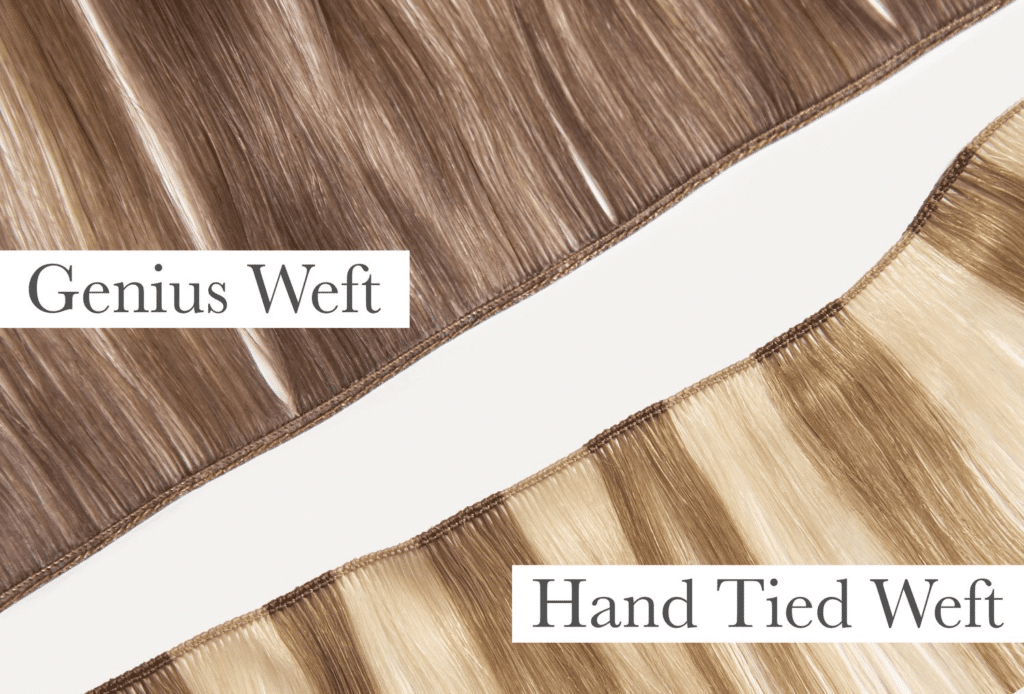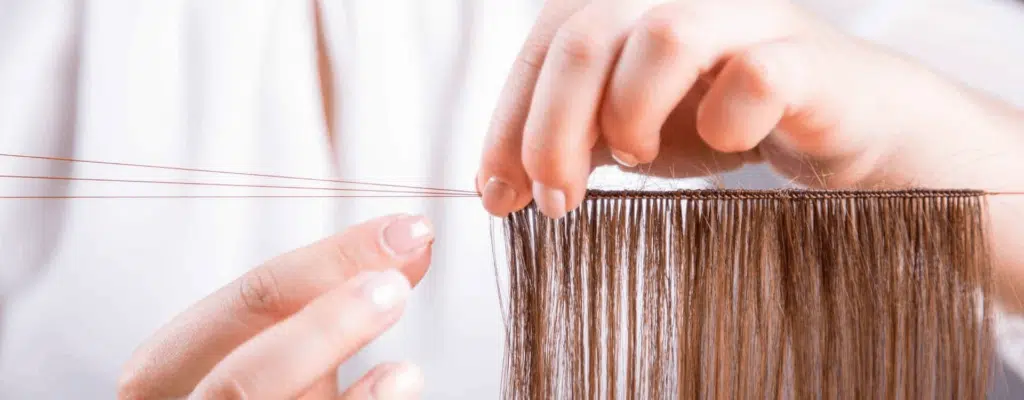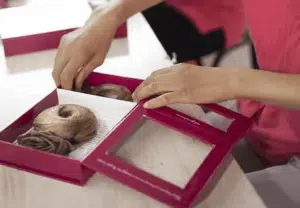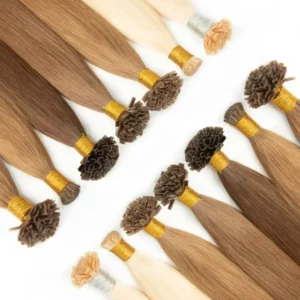You want rows that vanish, feel soft, and move like real hair. You also want stable supply, consistent specs, and predictable chair time. That is why salons compare genius wefts and hand-tied wefts so often.
Genius wefts are ultra-thin and cuttable anywhere with no return hair. Hand-tied wefts are artisan-made, ultra-flat, and lightweight but should not be cut. With the same raw hair, costs are similar; hand-tied is slightly higher and needs longer production. I suggest choosing based on comfort preference, workflow, and maintenance plans.

You will find clear definitions, real differences that matter for procurement and service planning, install method notes you can discuss with your stylist team, and a selection framework. I provide manufacturer-side suggestions, not end-user instructions.
What is a genius weft hair?
You want the invisibility of a thin seam with freedom to cut any width. You also want zero “beard” irritation. A genius weft was engineered for this.
A genius weft is an ultra-thin, sealed-edge weft with no return hair. You can trim it to size without shedding. It lies flat in beaded-row systems and helps sensitive clients feel less base friction. I suggest genius wefts when teams want faster customization and lower offcut waste.

A genius weft uses a low-profile composite stitch that seals the top while holding aligned strands. Because there is no folded “return hair,” the base feels smooth from day one. This design allows on-head customization: stylists can mark and cut micro-strips for precise widths without re-sealing the edge. That reduces material waste and shortens chair time. Typical band thickness is ~0.7–0.9 mm, which helps the row sit close to the scalp. When sourced as full-cuticle, single-donor hair, cuticle alignment reduces friction and supports color stability on blond shades. For salon owners, I suggest specifying “no-pierce” stitching just below the sealed edge to protect the band. Even tension, lined micro-beads, and balanced weight per row improve longevity over multiple move-ups.
What is a hand tied weft hair?
You want the flattest, most delicate seam with a luxury drape. You also value a handmade finish that feels especially soft against the scalp. That is the hand-tied promise.
A hand-tied weft is woven by artisans with a very thin stitch line. It is ultra-flat and light. It should not be cut; cutting can cause unraveling and shedding. I suggest hand-tied wefts when your brand story values hand craftsmanship and when clients prioritize a softer, more “fabric-like” top.

Hand-tied wefts earn their reputation from the seam’s hand-loomed construction. The stitch has minimal bulk, so the weft molds to the head shape and lays invisible under light partings. One extra advantage you can position in consultations: because the top is purely hand-woven, the contact area often feels softer and more comfortable for many clients. The artisan build has limits. Widths arrive fixed; if shorter pieces are needed, stylists must fold or plan with multiple narrow panels. Cutting the edge risks “running” the stitch. For procurement, I suggest full-cuticle hand-tied bundles to preserve shine and lifespan; tight QA on stitch density keeps the seam consistent from batch to batch. With disciplined technique and careful maintenance, hand-tied wefts deliver a refined, luxury result that many clients love.
What is the difference between genius weft and hand tied weft?
You want the practical gaps, not buzzwords. The differences show up in cut behavior, comfort feel at the top, workflow speed, waste rate, and supply planning. There is no major difference in where the two wefts can be worn on the head; both are used across standard row placements. I suggest choosing by service flow and client comfort, not by “position rules.”
Genius wefts are cuttable, have no return hair, and remain ultra-flat. Hand-tied wefts are the thinnest by feel, should not be cut, and their hand-woven top often feels especially soft and comfortable.
Cut behavior
Genius is designed to be cut anywhere with no shed. That speeds installs and improves yield per bundle. Hand-tied cannot be cut without risk, so teams pre-plan widths or fold strategically.
Top feel and comfort
Genius removes return hair, which helps reduce first-week itch reports. Hand-tied offers a uniquely soft, fabric-like top due to its pure hand weave; many clients find this very comfortable in daily wear.
Workflow and waste
Genius trims on the fly, reduces offcuts, and often shortens chair time. Hand-tied needs more pre-planning and sometimes more SKUs to cover widths, which can raise waste if widths do not match the map.
Position on the head
In practical salon use, there is no material placement restriction difference between the two. Both can be used in standard beaded-row placements as decided by the stylist. I suggest focusing on density mapping and tension balance, not on “this method only for crown/part/temple,” which is a misconception.
Quick table
| Factor | Genius Weft | Hand-Tied Weft |
|---|---|---|
| Cut anywhere | Yes | No |
| Return hair | None | Short return hair at fold |
| Top feel | Smooth, sealed | Extra-soft, hand-woven |
| Workflow | Faster, less waste | More planning, fixed widths |
| Placement rules | Standard rows | Standard rows |
How are they installed and maintained?
You need clean, vendor-neutral steps that protect the base and survive move-ups. Both wefts typically use a beaded-row foundation with fine stitching. I suggest aligning with your stylist team on tension standards, thread spec, and move-up cadence.
Both types follow similar care rules: brush daily, keep bases dry after washing, use sulfate-free shampoo, condition mids-to-ends, apply heat protectant, and book move-ups every 6–8 weeks.
Install notes (for stylist discussion)
1) Consult: map density, lifestyle, water hardness, and color history.
2) Prep: clarify if needed; dry smooth.
3) Foundation: place lined micro-beads at even intervals; standard row mapping applies to both weft types.
4) Weft handling: hand-tied—do not cut; fold or stack as planned. Genius—trim to width as needed; avoid piercing the sealed edge.
5) Stitch: use nylon/poly thread; anchor around beads, add inter-bead tacks; keep tension even.
6) Balance: distribute weight across 2–3 rows.
7) Blend: detail-cut for movement; test parting and high-tension styles.
Maintenance reminders
– Brush morning and night from ends to roots.
– Wash 2–3× weekly; fully dry the base after each wash.
– Keep oils and heavy masks away from the seam.
– Sleep in a loose braid on silk/satin.
– Rebook move-ups at 6–8 weeks; detox bases and shift seam positions slightly to protect anchors.
Troubleshooting
| Symptom | Likely Cause | Suggested Fix |
|---|---|---|
| Edge fray (genius) | Edge pierced during stitch | Restitch below edge |
| Corner bulk (hand-tied) | Fold stack too thick | Redistribute pieces |
| First-week itch | Return hair or product | Adjust product; micro-veil edges |
| Row tightness | Over-tensioned beads | Reset bead tension |

Cost, production time, and lifespan–genius weft vs hand tied
Owners want numbers and clear expectations. With the same raw hair quality, genius and hand-tied are similar in cost; hand-tied is slightly higher and needs longer production time due to manual weaving. I suggest reflecting this in delivery timelines, not just price sheets.
Both methods last many cycles on full-cuticle hair with good care. Move-ups land at 6–8 weeks. Real lifespan depends on water, heat habits, and maintenance.
Material economics
– Raw hair: specify full cuticle, single donor for both; this drives shine and lifespan.
– Wefting process: genius uses sealed-edge machinery and QC; hand-tied uses artisan weaving. The manual step adds time and a small cost delta.
Labor and scheduling
– Genius often saves 20–40 minutes per install because of on-head trimming and lower rework.
– Hand-tied needs more pre-planning and sometimes more SKUs to cover widths; factor this into booking.
Lifespan
Assuming full-cuticle hair and correct care, both can reach 12–24 months of useful life. Hard water, daily high heat, and chlorine reduce life; I suggest a care kit and a simple water-care script for front-desk teams.
Invoicing tip
Separate “hair cost” and “labor/service” lines. Keep a maintenance bundle that includes move-ups, detox, and dust trims to protect results and rebooking cadence.

My opinion
From a manufacturer’s view, I suggest genius wefts when your team wants faster customization, less waste, and zero return hair for comfort. I suggest hand-tied when your brand values the extra-soft, hand-woven top and the client expects a classic artisan seam. With full-cuticle hair and clean technique, both deliver premium results.
FAQ
Can genius wefts be cut anywhere?
Yes. The sealed edge allows trimming without shedding. I suggest stitching just below the edge.
Can hand-tied wefts be cut?
No. Cutting risks unraveling. I suggest planning widths in advance or using multiple narrow pieces.
Is there a difference in where each type should be placed on the head?
No material difference in standard practice. Both follow the same row mapping. Choose by comfort, workflow, and desired density—not by “position rules.”
Which feels softer at the top?
Many clients perceive the hand-tied top as especially soft due to the hand-woven seam. Genius feels smooth because there is no return hair.
Which costs more?
With the same raw hair, costs are similar. Hand-tied is slightly higher and needs longer production time because it is hand-woven.
How often are move-ups?
Every 6–8 weeks for both methods, based on growth and care.
Conclusion
Choose genius for cut freedom, speed, and no return hair. Choose hand-tied for the extra-soft, hand-woven top and classic luxury feel. Costs are similar; hand-tied runs slightly higher and longer to produce. Align the choice with comfort goals and workflow.
Hibiscus Hair Manufacturer has been dedicated to producing high-quality hair extensions for 25 years and is a recognized leader in the industry. If you are interested in finding a reliable hair extensions supplier and wholesale for your brand, please visit our website for more information:
HAIR WEFT





